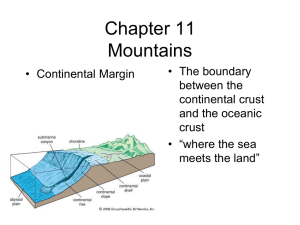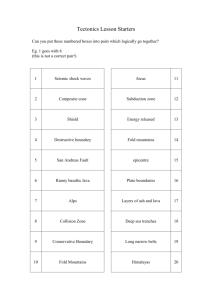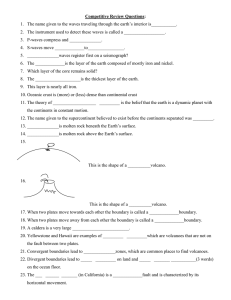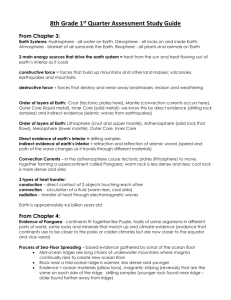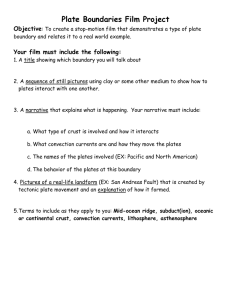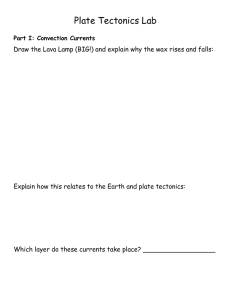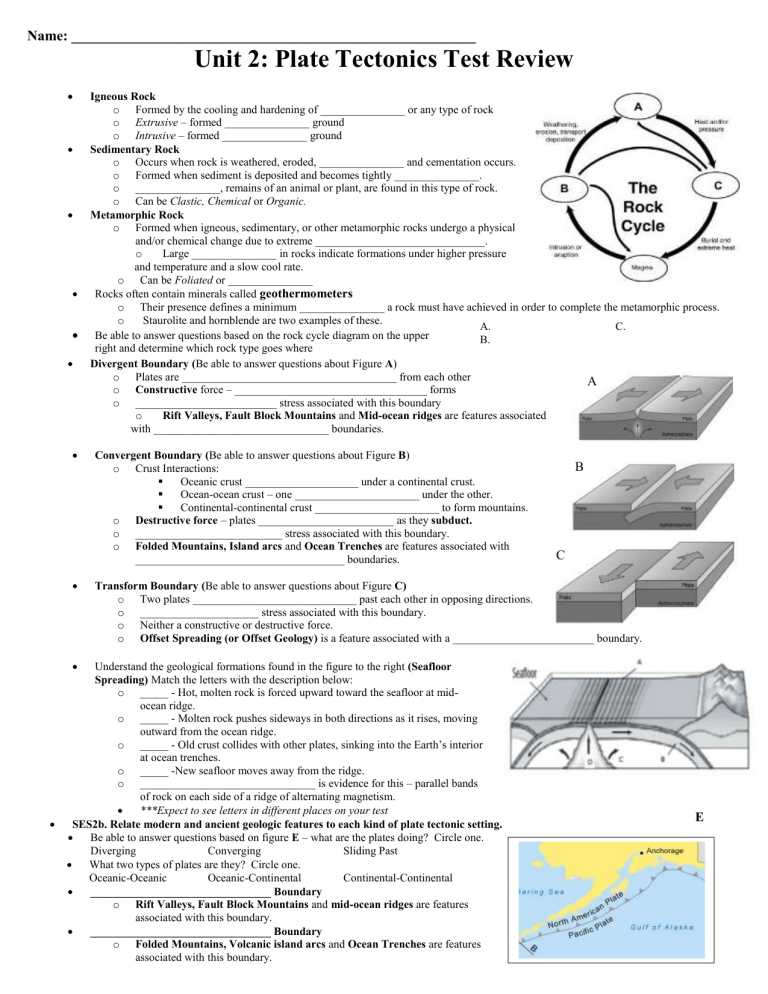
Name: ________________________________________________________ Unit 2: Plate Tectonics Test Review Igneous Rock o Formed by the cooling and hardening of _______________ or any type of rock o Extrusive – formed _______________ ground o Intrusive – formed _______________ ground Sedimentary Rock o Occurs when rock is weathered, eroded, _______________ and cementation occurs. o Formed when sediment is deposited and becomes tightly _______________. o _______________, remains of an animal or plant, are found in this type of rock. o Can be Clastic, Chemical or Organic. Metamorphic Rock o Formed when igneous, sedimentary, or other metamorphic rocks undergo a physical and/or chemical change due to extreme ______________________________. o Large _______________ in rocks indicate formations under higher pressure and temperature and a slow cool rate. o Can be Foliated or _______________ Rocks often contain minerals called geothermometers o Their presence defines a minimum _______________ a rock must have achieved in order to complete the metamorphic process. o Staurolite and hornblende are two examples of these. A. C. Be able to answer questions based on the rock cycle diagram on the upper B. right and determine which rock type goes where Divergent Boundary (Be able to answer questions about Figure A) o Plates are ______________________________________ from each other A o Constructive force – __________________________________ forms o _________________________ stress associated with this boundary o Rift Valleys, Fault Block Mountains and Mid-ocean ridges are features associated with _______________________________ boundaries. Convergent Boundary (Be able to answer questions about Figure B) o Crust Interactions: Oceanic crust ____________________ under a continental crust. Ocean-ocean crust – one ______________________ under the other. Continental-continental crust ______________________ to form mountains. o Destructive force – plates ________________________ as they subduct. o __________________________ stress associated with this boundary. o Folded Mountains, Island arcs and Ocean Trenches are features associated with _____________________________________ boundaries. B A C Transform Boundary (Be able to answer questions about Figure C) o Two plates _____________________________ past each other in opposing directions. o _____________________ stress associated with this boundary. o Neither a constructive or destructive force. o Offset Spreading (or Offset Geology) is a feature associated with a _________________________ boundary. Understand the geological formations found in the figure to the right (Seafloor Spreading) Match the letters with the description below: o _____ - Hot, molten rock is forced upward toward the seafloor at midocean ridge. o _____ - Molten rock pushes sideways in both directions as it rises, moving outward from the ocean ridge. o _____ - Old crust collides with other plates, sinking into the Earth’s interior at ocean trenches. o _____ -New seafloor moves away from the ridge. o _______________________________ is evidence for this – parallel bands of rock on each side of a ridge of alternating magnetism. ***Expect to see letters in different places on your test SES2b. Relate modern and ancient geologic features to each kind of plate tectonic setting. Be able to answer questions based on figure E – what are the plates doing? Circle one. Diverging Converging Sliding Past What two types of plates are they? Circle one. Oceanic-Oceanic Oceanic-Continental Continental-Continental ________________________________ Boundary o Rift Valleys, Fault Block Mountains and mid-ocean ridges are features associated with this boundary. ________________________________ Boundary o Folded Mountains, Volcanic island arcs and Ocean Trenches are features associated with this boundary. E _________________________________ Boundary o Offset Spreading (or Offset Geology) is a feature associated with this boundary. The shape and appearance of mountains are clues to their _______________. o Appalachian Mountains Rounded and weathered peaks indicate ______________________________ age. They formed around 480 million years ago when ancient plates collided. o Rocky Mountains High, jagged peaks indicate _____________________________ mountains. Formed between 55-80 million years ago at divergent boundary. o Himalayan Mountains _________________________________ mountain range on planet—still forming. Result of collision of Eurasian Plate and Indo-Australian Plate. Be able to identify the four types of mountains in the illustrations below—label (A) dome, (B) fault block, (C) fault-block, (D) volcano _______________ _______________ _______________ Understand the diagram F below with respect to the colliding of continental and oceanic plates. Pay careful attention to arrows and names of the plates. _______________ _______________ F G H g G In diagram G above you must understand o The plates are moving ____________________________ o This is an example of a _______________________________ boundary. o Features formed include _______________________________ Mountains. o Stress associated with this is ____________________________________. The faults shown in the northwest part of Georgia on the map H are convergent and we have the foothills of the Appalachian Mountains. o If the faults were ___________________________ we would have a rift valley and/or fault block mountains. o If the faults were ___________________________ we would have offset geological features. Earth's major ore deposits occur at _________________________ boundaries. o These are destructive forces. Metamorphism most often occurs along a _______________________ boundary Manganese nodules are most often found along a _____________________________ boundary on oceanic crusts Using figure J be able to answer the following questions. Pay attention to the arrows indicating the movement of the plates o _________________________ Boundaries ( ) I J o o Most likely place to find gold and __________________ minerals. _________________________________ Boundaries ( o o Most likely place to find sulfur and _________________ minerals. _____________________________ Boundaries ( ) o San Andreas Fault in _________________________ is an example. )
